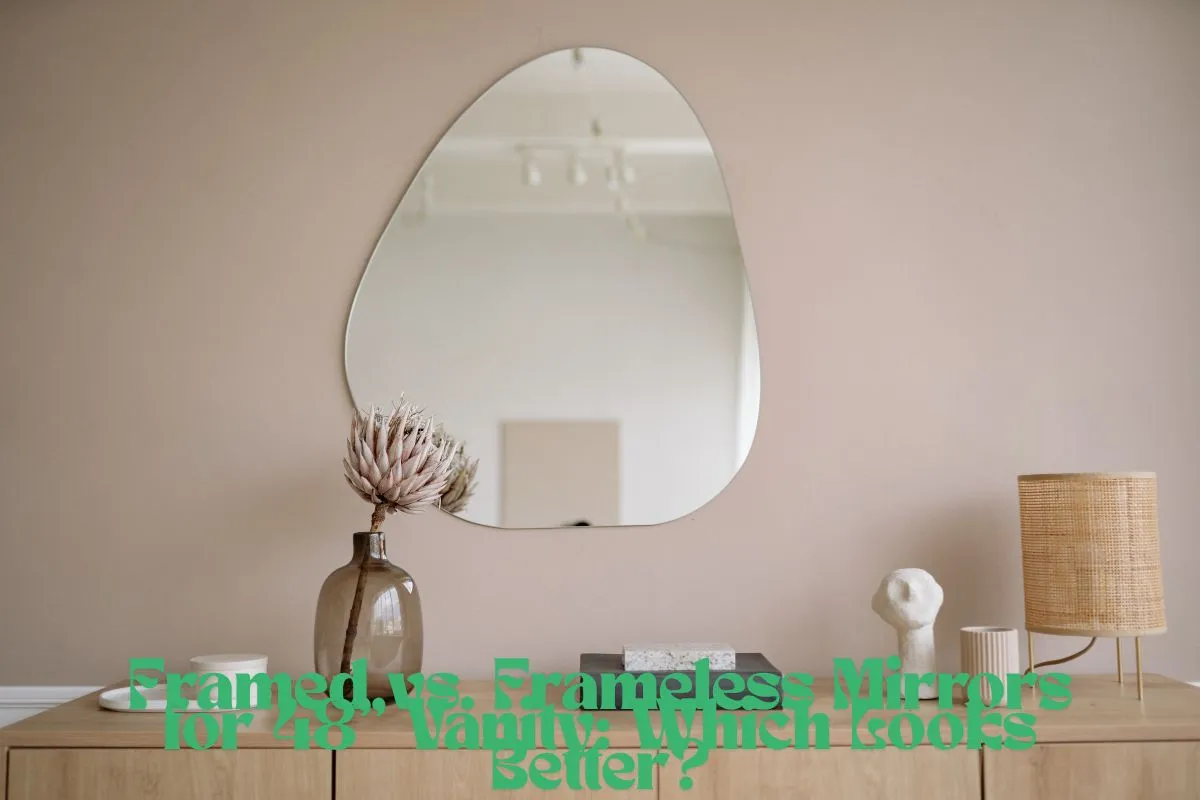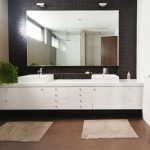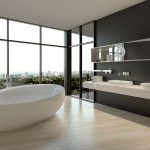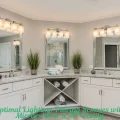Choosing a mirror for your 48-inch vanity is not just about functionality. The mirror becomes a focal point of your bathroom. And one big question always pops up — framed or frameless? What looks better? Which suits your space, budget, and taste?
In this guide, we’ll use expert insights, mirror size tips, and practical advice to help you decide between framed and frameless mirrors for a 48 “vanity. Whether you’re redesigning your bathroom or simply upgrading your vanity mirror, this guide will give you clarity—pun intended!
What Size Mirror for 48 Vanity?
Before diving into the styles, let’s cover the basics. What size mirror for a 48 vanity is ideal?
Generally, the mirror width should be 2 to 4 inches shorter than the vanity width. That means your mirror size for 48 inch vanity should be around 40 to 46 inches wide.
A safe and visually balanced option is a mirror size of 44 inches wide and about 36 inches high. This fits neatly over your vanity, giving you ample reflection without overpowering the space.
Mirror Size Chart for Vanities
Here’s a quick mirror size chart reference:
| Vanity Size | Recommended Mirror Width |
|---|---|
| 24” | 20”–22” |
| 36” | 32”–34” |
| 48” | 42”–46” |
| 60” | 54”–58” |
This bathroom mirror sizing tip can help you avoid mirrors that are too narrow or awkwardly wide. A mirror width to vanity ratio of about 90% is usually spot on.
Framed Mirrors: Classic and Defined
Framed mirrors are what most people picture when thinking of a vanity mirror. They come with a built-in border made from wood, metal, or plastic. Some are ornate and decorative, while others offer a clean, simple trim.
✅ Pros of Framed Mirrors:
-
Style Versatility: Available in rustic, modern, vintage, and coastal designs.
-
Polished Finish: A frame adds a completed look to the wall.
-
Color Coordination: Match your bathroom cabinet, faucet, or towel bars.
-
Better for Traditional Bathrooms: Ideal if your space has lots of woodwork or detail.
❌ Cons of Framed Mirrors:
-
Less Sleek: The frame can feel bulky in a minimalist space.
-
Size Restrictions: The outer frame adds extra inches, so a 44-inch framed mirror may feel larger on the wall.
-
Harder to Clean: Dust and moisture can settle on the frame edges.
User Tip: I once tried a thick black framed mirror over my 48-inch vanity. While it matched my vanity hardware, it made the space feel tighter. I ended up switching to a thinner frame—and it instantly felt more open.
Frameless Mirrors: Sleek and Modern
Frameless mirrors are all about simplicity. They’re usually just a clean-cut glass sheet with polished or beveled edges, attached to the wall with clips or adhesive.
✅ Pros of Frameless Mirrors:
-
Minimalist Look: Perfect for contemporary and modern bathrooms.
-
Space Enhancing: Makes a small room appear larger and more open.
-
Flexible Fit: You can go almost edge-to-edge without the bulk of a frame.
-
Easier Maintenance: No frame to trap dust or moisture.
❌ Cons of Frameless Mirrors:
-
Less Personality: Can feel too plain in some decor styles.
-
Requires Wall Prep: Uneven walls may make them harder to install neatly.
-
Exposed Edges: Though polished, they’re still glass—more prone to chipping than framed styles.
Anecdote: When we renovated our guest bath, my husband insisted on a frameless mirror. At first, I wasn’t sure—it looked a bit sterile. But once paired with matte black sconces and white subway tile, the whole space looked clean, bright, and bigger.
Mirror Width Guide: Which Style Fits Better?
So, what size mirror for a 48 vanity works best based on style?
For Framed Mirrors:
Go slightly narrower. A 42–44 inch framed mirror works best so the outer edge doesn’t spill over the vanity width. Also, take into account the frame thickness—some decorative mirrors can add 2 inches on each side!
For Frameless Mirrors:
You can go wider, up to 46 inches, since there’s no border taking up visual space. Frameless styles let you get closer to a full-width mirror look without overwhelming the vanity.
Bathroom Mirror Dimensions and Proportions
Think beyond width. Ideal mirror height matters too.
A good mirror height is 30 to 36 inches, depending on your ceiling height and faucet placement. Taller mirrors elongate the wall and are great for rooms with standard 8-foot ceilings. Mirror size recommendations also depend on your lighting. If you use overhead lights, a taller mirror reflects more light and brightens up your face better.
And yes, mirror selection for vanities should also consider your bathroom’s layout, color palette, and how much storage or cabinetry surrounds the mirror.
Which One Looks Better: Framed or Frameless?
It depends on your taste and bathroom vibe. But here’s a quick style breakdown:
| Style | Framed Mirror | Frameless Mirror |
|---|---|---|
| Look | Decorative, defined, traditional | Sleek, open, modern |
| Best Bathroom | Rustic, vintage, transitional | Contemporary, minimalist |
| Size Impact | Adds bulk, feels narrower | Feels wider, lighter |
| Maintenance | Harder to clean frame edges | Easy to wipe, no corners |
| Popular Width | 42″–44″ for 48” vanity | 44″–46″ for 48” vanity |
Mirror Size Selection: Design Tips
Here are some helpful mirror size guidelines and design tips:
-
Pair framed mirrors with vanity lights on each side for symmetry.
-
Use frameless mirrors in small bathrooms to maximize light.
-
Match mirror width to your sink, not just the vanity. Double-sink vanities might need two narrower mirrors instead of one large one.
-
Add sconces or LED backlights for a spa feel—both framed and frameless mirrors can benefit from smart lighting.
Final Thoughts
Choosing between framed vs. frameless mirrors for a 48” vanity comes down to personal style and bathroom needs. If you love charm and character, a framed mirror is timeless. If you prefer a clean, modern look, frameless is the way to go.
Whatever you choose, remember to follow the mirror width guide, use the mirror size chart for vanities, and keep things proportional. It’s not just about what looks better—it’s also about what fits and feels better in your space.
FAQs
Q: Is a 48-inch mirror too wide for a 48” vanity?
A: Technically, no. But it’s visually better to have a mirror 2–4 inches narrower than the vanity. So a 44–46 inch mirror is ideal.
Q: Should a mirror be wider than the vanity?
A: No. The mirror should be the same width or slightly narrower. Wider mirrors can look unbalanced.
Q: Can you mix a framed mirror with modern decor?
A: Absolutely. Choose a thin metal frame in black or brass for a modern twist on a classic design.










